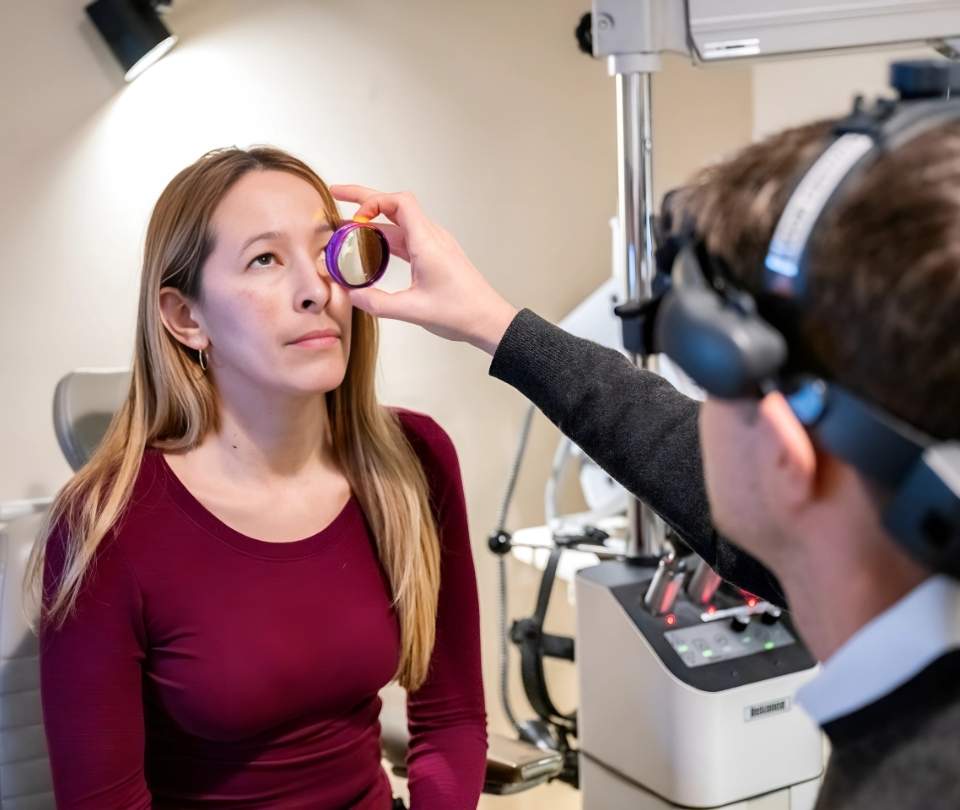Cataract Patients and Dry Eye


Request an Appointment
Cataract patients commonly face the discomfort of dry eye symptoms, a condition marked by insufficient tear production or increased tear evaporation. This phenomenon is especially significant after cataract surgery, where minor nerve disturbances during the procedure can temporarily reduce tear production. It’s important for patients to understand the interplay between these two conditions so they feel confident in discussing symptoms with our eye doctors. Associated Eye Physicians & Surgeons of NJ proudly offers eye care at four convenient locations: Belleville serving Essex County, Rahway serving Middlesex and Union Counties, Jersey City serving Hudson County, and Union serving Union County.
How Cataracts and Dry Eye Intersect
Cataracts and dry eye syndrome are two distinct eye conditions that often coexist. Cataracts occur when proteins in the eye’s natural lens clump together, clouding vision gradually. On the other hand, dry eye syndrome involves an imbalance in tear production or tear film stability, leading to irritation, burning, and a gritty sensation. Although one does not directly cause the other, many patients with cataracts notice symptoms of dry eye, particularly following surgery.
During cataract surgery, small incisions are made in the eye to remove the cloudy lens. This surgery, while generally safe and highly effective, can temporarily affect the nerves on the surface of the eye. These nerves are crucial because they send signals to produce tears that keep the eye lubricated. When these nerves are disrupted, even subtly, the feedback loop that triggers tear production is interrupted, leading to dryness. For individuals with pre-existing dry eye, these symptoms may be more pronounced, making recovery feel a little more uncomfortable.




Why Do Cataract Patients Experience Dry Eye?
There are several reasons why patients undergoing cataract surgery may experience dry eye symptoms. One of the primary contributors is the surgical process itself. Even though modern cataract surgery is minimally invasive, the small incisions made during the procedure can affect the ocular surface nerves. These nerves are integral in stimulating tear production, so any disruption can lead to reduced lubrication in the eye.
Additionally, many cataract patients are older adults. As we age, our bodies naturally produce fewer tears, and the quality of our tear film may decline. Environmental factors such as wind, dry air, or even prolonged exposure to computers and digital devices can further aggravate this condition. For patients already balancing the challenges of cataract-related vision changes, the onset or worsening of dry eye can add another layer of discomfort.
Who Is More Likely to Experience Dry Eye?
Although both men and women can experience dry eye, research shows that women are generally more prone to the condition. Hormonal differences play a significant role in tear production and ocular surface maintenance. For female cataract patients, this means that the symptoms of dry eye might be more noticeable and, at times, more disruptive. Understanding this predisposition is essential, as it emphasizes the need for early recognition and treatment of dry eye symptoms.


Pre-Surgical Considerations
Ensuring that the ocular surface is healthy before cataract surgery plays a vital role in achieving optimal surgical outcomes. An irregular tear film can affect the accuracy of measurements needed to determine the best intraocular lens (IOL) for your surgery. For patients with dry eye, managing the condition prior to surgery can help stabilize the tear film and lead to more predictable results.
Our eye doctors often recommend that patients with noticeable dry eye symptoms take steps to improve their ocular surface health before undergoing any surgical procedure. This might involve the use of artificial tears, prescription drops, or even advanced in-office treatments, ensuring that the eyes are well-lubricated. A stable tear film is not only essential for the surgical process but also for a smoother and more comfortable recovery afterward.


Management and
Treatment Strategies
Managing dry eye symptoms in cataract patients requires a tailored approach that takes into account the individual’s ocular health and the severity of symptoms. For many patients, simple over-the-counter artificial tears provide significant relief. These lubricants help to maintain moisture on the surface of the eye while the natural production is recovering or compensating for changes after surgery.
For patients with moderate to severe dry eye, prescription medications such as anti-inflammatory eye drops may be recommended. There are also specialized in-office treatments available that target meibomian gland dysfunction—a common underlying cause of dry eye. Ensuring proper eyelid hygiene and making environmental adjustments can also contribute to improved tear film stability and overall comfort.
What to Do If You Experience Dry Eye Symptoms
If you are a cataract patient and begin to notice symptoms of dry eye, it is crucial to discuss these changes with our eye doctors. Early detection and intervention can make a significant difference in your comfort and vision outcomes. Even if the symptoms seem mild, they can indicate that the ocular surface is not in its optimal state, which might affect both your everyday activities and surgical recovery if you are planning road cataract surgery.
Your doctor might suggest a more in-depth evaluation to measure tear production and assess the overall quality of the tear film. Tests such as tear break-up time and tear meniscus height measurements can help pinpoint the issue. Based on the findings, a tailored treatment plan is created to address the specific needs of your eyes.
Your Trusted Eye Doctors Serving Central and Northern NJ
In summary, managing dry eye symptoms is crucial for cataract patients to ensure a smooth surgical experience and recovery. By understanding the interplay between cataracts and dry eye, patients can better advocate for their eye health with our eye doctors. Proper evaluation and tailored treatment plans can significantly improve comfort, minimize discomfort, and enhance overall vision outcomes. At Associated Eye Physicians & Surgeons of New Jersey, we are committed to providing comprehensive eye care that addresses all aspects of your ocular health. Experience personalized, expert eye care by scheduling an appointment with our eye doctors in Belleville, Jersey City, Rahway, or Union, NJ.
Request an Appointment
- Cataract Surgery
- Cataract Surgery With Diabetes
- Cataract Surgery Benefits and Advantages
- Cataract Surgery Options: Laser-Assisted vs. Traditional
- Cataract
- Cataracts and Smoking
- Driving At Night Before and After Cataract Surgery
- Eye Drops After Cataract Surgery
- Femto-Second LASER Cataract Surgery
- High Blood Pressure and Cataracts
- Is Cataract Surgery Safe?
- Recovery After Cataract Surgery
- The Best Sleeping Position Post Cataract Surgery
- When Can You Drive After Cataract Surgery?
- Why is Cataract Surgery Done on One Eye At a Time?
- Cataract Patients and Dry Eye
- YAG laser Capsulotomy
At Associated Eye Physicians of NJ, we’ve built our reputation on care that’s local, personal, and easy to get to. With offices in Belleville, Union, Jersey City, and Rahway, we’re proud to serve a wide range of communities across North and Central Jersey. Our Belleville team welcomes patients from all over Essex County, including Newark, Bloomfield, and Nutley. Rahway welcomes patients from across Middlesex and Union Counties, including nearby patients from Elizabeth, Avenel, Woodbridge, and Perth Amboy. Our Union office is a favorite for families from Union County, especially for those in Elizabeth and Cranford. And in Jersey City, we care for Hudson County residents, including our neighbors in Hoboken and Bayonne.
